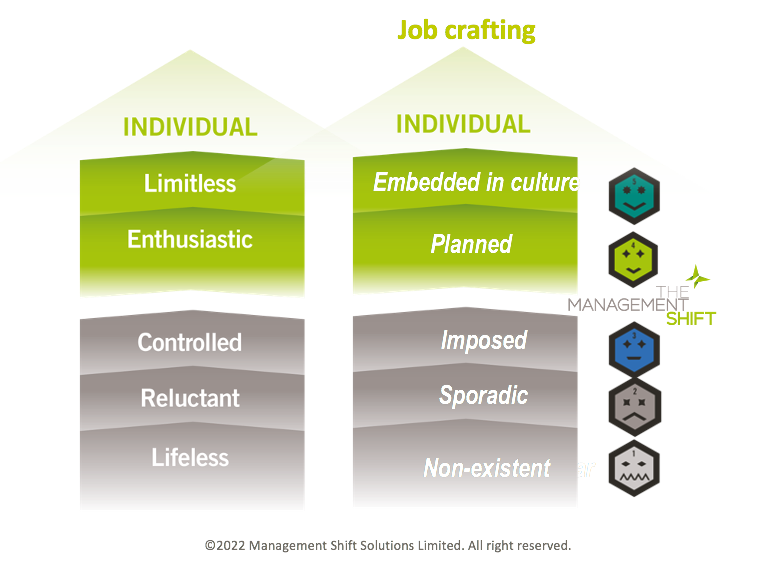How job crafting can help employers create meaningful workplaces
- 6 Min Read
By allowing employees to customize their jobs to fit their unique skills and interests, job crafting can help employers create a more engaged and motivated workforce.
- Author: Vlatka Ariaana Hlupic
- Date published: Jul 4, 2022
- Categories

Since the onset of COVID-19 and lockdowns, people have been looking for more meaning in their careers and working life.
For many, this means finding ways to connect their personal passions with their professional lives. Across the board, workers are learning how they can creatively harness control over their jobs, comprehend the way their work is perceived, and decide which social engagements and associations they should encounter at work. The term for this type of activity is often referred to as job crafting.
Since the early 2000s, job crafting has been recognized as an important way to increase employee engagement and satisfaction.
There are 3 primary aspects of job crafting:
- exercising greater control over tasks
- determining the way tasks are perceived
- deciding which social contexts and relationships are best for achieving work goals
Each of these aspects can be used to improve employee satisfaction and productivity.
Why it matters
An office worker might decide to take on additional tasks related to her interests, such as designing marketing materials or researching new products. By taking control of these tasks, she/he can make their work more meaningful and interesting. She/he may also be more likely to put in extra effort if she/he perceives their work in a positive light, such as seeing herself/himself as contributing to a larger goal or helping others. Finally, she/he can choose the social contexts and relationships that will allow her/him to best achieve her/his goals, such as working with supportive co-workers or seeking out feedback from superiors.
For both employees and organizations, the benefits of job crafting include greater job satisfaction, engagement, and motivation. The employees whose jobs they craft tend to be more creative and productive and are less susceptible to burnout.
In a study of 238 nurses, job crafting was found to be one of the strongest predictors of engagement.
As referenced from the above article, registered nurses in public health are actively job crafting by emphasizing and initiating tasks that are based on strengths and passions.
Examples included training students and new staff, participating in workgroups and committees, and being involved in projects. Nurses proactively modified the processes of the tasks to better meet client needs and improve the quality of care.
Job crafting facilitators and barriers included availability of opportunities, support from management, experience/level of skill of the nurse, limitations in the role, and heavy workload/insufficient staffing. The ability to continually modify tasks at the point of care, using evidence-based approaches and utilizing education and professional development facilitated job crafting. Nurses reported that improving work meaningfulness was a driver of job crafting.
The equation for job crafting is constantly changing with the addition of new factors.
One such factor is the growth in remote working. Employees are working from home or in hybrid workplaces more than ever before. This changes the dynamics of how job crafting can be done, as it can now be influenced by co-workers who are not physically present.
Additionally, the trend towards remote working may have an indirect impact on job crafting through its influence on employee engagement and work-life balance.
How does job crafting impact organisations in the longer term?
In the last year, there has been a Great Resignation issue. Employees are starting to choose the companies they are wanting to work for, and job crafting may well be the key to unlocking flexibility in the workplace.
When employees feel like their job is meaningful, they are less likely to leave their position. This can lead to lower turnover rates and reduced recruitment and training costs.
In the context of 5 level The Management Shift model, (Figure 1.) job crafting becomes natural and easier at Levels 4 and 5. At Level 4 it is planned and it is embedded in work plans and activities. At Level 5 it gets embedded in organisational DNA.
On the other hand, at Level 3 it is imposed by managers to improve organisational KPIs, at Level 2 it is very sporadic and random, and at Level 1 it does not exist at all.

Figure 1. Job crafting mapped to the 5 Levels of The Management Shift framework
4 ways to incorporate job crafting into your organization
- Understand your employees’ strengths, skills and weaknesses: Employers should take the time to understand their employees’ strengths, skills, and weaknesses in order to craft their job duties accordingly. A variety of tools can be used for this purpose, such as skills-based assessments, motivational assessments and employee surveys. By doing so, employers can help their employees to be more engaged and productive in their work.
- Create room for career growth, create positive challenges, upskilling and learning: This can involve things such as adding new challenges or tasks to the role, upskilling and learning new skills, or taking on additional responsibilities. By doing this, employees can create more space for career growth and development, while also enjoying a more positive and challenging work experience.
- Prioritise flexible working: Flexible working can help employees to better manage their work-life balance, which in turn can improve their productivity and motivation. It can also allow them more time to focus on their personal priorities outside of work, such as caring for children or elderly relatives. For organisations, offering flexible working arrangements can help to retain talented staff, and promote a positive image externally. It can also increase employee satisfaction and productivity, as staff feel that they are able to better manage their own lives.
- Communicate and coach your employees: By talking to your employees and getting a sense of what they find meaningful in their work, you can help them to create a job that is tailored to their specific skills and interests. Provide them with some pathways, options, but give them the chance to come up with their own ideas and pathway.
To conclude, job crafting is a powerful tool that can help employers harness the meaning in their employees’ work and improve their productivity, creativity, and satisfaction. By allowing employees to customize their jobs to fit their unique skills and interests, job crafting can help employers create a more engaged and motivated workforce. So, if you’re looking for a way to improve your organization’s performance, consider using job crafting to unlock the potential of your employees.
Vlatka Ariaana Hlupic is Professor of Leadership and Management at Hult International Business School (Ashridge) and founder and CEO of Management Shift Solutions Limited.









